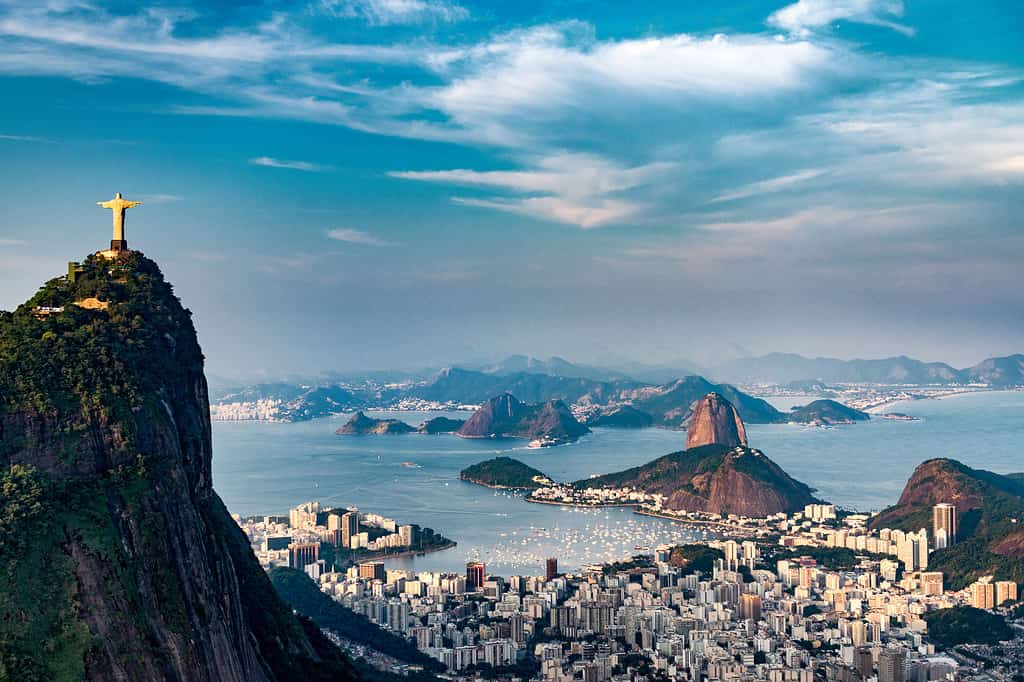Located atop the Corcovado Mountain in Rio de Janeiro, Brazil, the Christ the Redeemer’s iconic status ranks as one of the seven modern wonders of the world. The statue beckons tourists worldwide who take the dangerous trek up Mount Corcovado. Made in the Art Deco style, it is one of the largest Christ statues in the world.
On October 12, 1931, the Christ the Redeemer statue was unveiled in Brazil. It stands at 98 feet tall and 92 feet wide (with the statue’s arms outstretched). Corcovado Mountain itself reaches 2,300 feet tall and overlooks the city of Rio de Janeiro, Brazil’s principal port city. The iconic Christ the Redeemer statue has come to be symbolic for both Rio de Janeiro and the nation of Brazil.
Though this statue is undoubtedly recognizable and automatically associated with Rio de Janeiro’s skyline, the history of Brazil’s Christ the Redeemer is typically less known. Before we talk about how the statue was built, let’s start with its history.
History of Brazil’s Christ the Redeemer

This is Corcovado Mountain with the statue of Christ the Redeemer.
©microgen/iStock via Getty Images
The idea for the statue started with the germ of an idea back in the 1850s. The Vincentian priest Pedro Maria Boss (also known as Pierre-Marie Bos) suggested that a statue be erected to honor Princess Isabel, daughter of Emperor Pedro II.
Princess Isabel’s Abolition Law
While Princess Isabel’s father was absent abroad, she acted on her father’s behalf. When her father fell ill in 1887, she served as regent of Brazil. Her role as acting regent was amidst growing talk of abolition. On May 13, 1888, Princess Isabel signed the “Golden Law” (A Lei Áurea), which abolished all forms of slavery. As Princess Isabel’s legislative order carried out the cessation of all slavery across the nation, plantation owners lost their enslaved workers. Subsequently, the Golden Law led to the fall of Brazil’s monarchy.
The Golden Law as a piece of legislation is only 18 words, but it remains one of the most important pieces of Brazilian history—despite the ramifications it had for Brazil’s government structure.
How Corcovado Mountain Inspired Priest Boss
Princess Isabel’s efforts to end slavery prompted Priest Boss to request a monument, but that was only part of the initial inspiration. Priest Boss resided at the Immaculate Conception School, which overlooked Corcovado Mountain. In his work The Imitation of Christ from 1903, his preface includes a famous poem that describes his vision for a monumental statue of Jesus on top of Corcovado.
However, Priest Boss’s interest in a monument is in response to a more significant cultural shift. With the pending separation of church and state, the citizens of the nation, particularly those in the capital of Rio de Janeiro, feared an imminent godless country.
In discussion with Princess Isabel, Priest Boss proposed a monument and requested financial assistance. Once Brazil became a republic, conversations about the statue ceased. Subsequently, the first proposal was dismissed.
The origins of Christ the Redeemer can be traced to this moment. However, no official action was taken at the time. In 1920, a second proposal was submitted. In addition to the proposal, Brazilian Catholics also provided funding for the statue. The proposal was accompanied by several design suggestions. On April 4, 1922, the base of the foundational stone was laid. This date happened to coincide with the centennial of Brazil’s independence from Portugal, commemorating the occasion.
Christ the Redeemer’s Design

Christ the Redeemer’s arm span is approximately 92 feet wide.
©Inge Strijkers/Shutterstock.com
In 1922, there still wasn’t an official consensus about the statue’s design. Later that year, there was a competition to find a designer.
Heitor da Silva Costa, a Brazilian engineer, was initially chosen as a designer based on his preliminary sketches. However, the final version, which is now known as Christ the Redeemer, went through several different variations and artists. The final design, which has arms outstretched to signify Christ’s crucifixion, was developed in collaboration with artist Carlos Oswaldo.
The project still took another nine years to complete, even after the foundation had been laid in 1922. By 1927, a steel frame had been erected at the top of Corcovado. It took ongoing discussion to determine the statue’s exterior finish.
“We were marching towards the inevitable artistic failure, without being able to go back,” Silva Costa said.
Establishing a Design Team
In 1924, Silva Costa visited Europe and met with French engineer Albert Caquot. Together, the team met with several sculptors. After Oswaldo’s final sketch was decided on, French-Polish sculptor Paul Landowski designed a miniature version of the statue. The mockup stood at approximately 13 feet tall.
Transporting the statue from Europe to South America would be a difficult process. To simplify the transportation process, Landowski would first produce full-size clay pieces of the sculpture. Then, these pieces were transported to Brazil.
Once in Rio, the clay pieces were reproduced in concrete. Silva Costa was initially against concrete because of its crude-looking exterior. However, while in Europe in 1924, he was intrigued by a fountain near Champs Elysees. The fountain was covered in tiny mosaic tiles, prompting Silva Costa to consider alternatives to concrete. The final version of Christ the Redeemer is covered in soapstone, which was initially inspired by Silva Costa’s fountain encounter in Europe.
Soapstone had been used by an 18th-century sculptor. The sculptor produced his work in a state north of Rio de Janeiro, and even 120 years later, the material proved to be durable. According to Bel Noronha, Silva Costa’s great-great-granddaughter, the longevity of the soapstone is what eventually sold him on the material.
Silva Costa decided to use a pale soapstone from quarries near the city of Ouro Preto.
The Construction of the Statue
In 1926, construction officially began and continued for five more years. Caquot was tasked with designing the internal structure of the statue. He had to configure how the statue would support the weight of the concrete. As Landowski’s sculpted pieces arrived in Brazil, a team of workers would haul water from a nearby fountain to prepare the cement.
Corcovado Mountain is exceptionally steep, and a railway cart was installed to assist workers with transporting the materials up the mountainside. A scaffolding system was later added to the exterior of the statue, which workers climbed daily to reach the upper parts of Christ the Redeemer.
Once the concrete sculpture was complete, a team set out to cover the entire surface with nearly 6 million soapstone tiles. There are rumors that the workers wrote notes on the back of the tiles, imbuing the iconic landmark with potentially millions of hidden messages.
The design and construction of the statue took nine years to complete, costing nearly $5 million in USD, as of today’s current rates. The statue officially opened to the public on October 12, 1931, which coincided with the day of the patron saint of Brazil, Our Lady of Aparecida.
In 2007, the statue of Christ the Redeemer was chosen as one of the Seven Wonders of the modern world.
Today, Christ the Redeemer is located in Tijuca National Park in Alto de Boa Vista in the city of Rio de Janeiro, Brazil. There are three options to reach the monument: train, van, or walk.
Christ the Redeemer: A Cultural Symbol
Christ the Redeemer continues to be a popular attraction and a symbol of Brazilian culture. Interestingly, the statue is struck by lightning at least three times a year. In 2014, before the FIFA World Cup, lightning broke one of the statue’s thumbs.
The original stone is no longer available, so darker stone shades have to be used to replace the original. Because of this, the Christ the Redeemer statue is slowly darkening.
Christ the Redeemer, in all of its historical and religious representation, continues to inspire a strong connection between those who live closest to it. Millions visit the statue annually, but the statue, constantly visible to those who live nearby, serves as a symbol of the Brazilian community, not just as a religious marker, but also as a contribution to art and science.
The photo featured at the top of this post is © iStock.com/ValterCunha
Thank you for reading! Have some feedback for us? Contact the AZ Animals editorial team.







